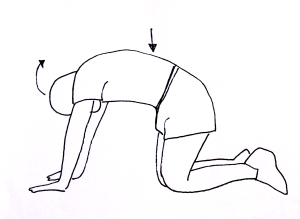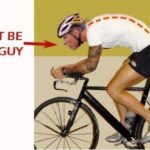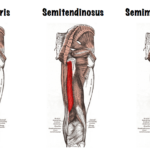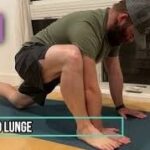When you wake up in the morning with a crick in your neck, or feel a burning on the top of your shoulder blade, or have trouble turning your head to look behind you when you’re driving, the culprit may be your Levator Scapulae!
Anatomy

Origin: Transverse Processes of the Cervical Vertebrae (Upper 3 or 4)
Insertion: Medial Border of the Scapula (Superior part)
In Other Words…
The Levator Scapulae starts out as four little muscles attached to the sides of the first four vertebrae in your neck, deep to the trapezius muscle. The fibers twist around themselves and ascend either side of the neck. They then join together into one muscle and appear from under the trapezius. The Levator Scapulae attaches to the top of your shoulder blade.
When do you use your Levator Scapulae?
The Levator Scapulae works in conjunction with other muscles of the back to help you raise or shrug our shoulders, look up to the sky or turn our head to one side.
When swimming, the Levator Scapulae is engaged when we turn our head for side-breathing, and when reaching for a glide. When running, the Levator Scapulae works when the arm retracts. Cyclists may shorten their Levator Scapulae if the shoulders are shrugged reaching for the handle bars.
Moving the Shoulder Blade:
– Elevation of scapula: raising your shoulder blades directly upward
– Downward rotation of the scapula: placing your arm behind your back
– Adduction of the scapula: moves the shoulder blade toward the midline of the body
Moving the Cervical Spine:
– Rotation of cervical spine to the same side: turning your head to look over your shoulder
– Extension of the cervical spine: moving your chin and neck back and away from your chest, as if to look at the sky
– Lateral flexion of the cervical spine to the same side: bringing your left ear to your left shoulder and right ear to right shoulder
Levator Scapulae Pain and Tension
In athletes and others involved with physical activities, the most likely cause of Levator Scapulae tension is overuse. Failure to warm up correctly before activity or to stretch and strengthen the neck muscles regularly is a common contributing factor. Another is to train for extensive periods when the muscles have become noticeably weakened. Greatly increasing your exercise program very quickly does not allow the muscles sufficient time to adjust and may also cause tension. Other contribution factors could be maintaining bad posture at a computer, compensation due to an injury, or any repetitive motion. Often, overuse tension in the Levator Scapulae muscle can occur from the muscle working to stabilize the head – therefore working to not move!
Pain can be described as a throbbing, ache, or tightness, and is usually presented above the shoulder blade up to the neck. Stretching and strengthening the upper back, neck and chest muscles helps relieve pain and tension, and prevent it from returning.
Stretching Exercises for the Levator Scapulae
When stretching, it is important tobreathe fully, deeply and slowly. As you feel the muscle relax you will notice your head moves more fully into the stretch position.
Neck Flexion Stretch
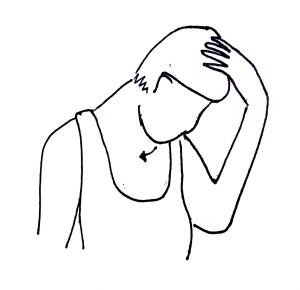
– Start in a neutral position, chin elevated and shoulders dropped.
– Slowly drop the head forward by bringing your chin toward your chest
– You should feel a gentle tension up the back of the neck
To increase the stretch, bring either arm over your head, grasp the back of the head with your hand, and gently pull the head from behind
Variation:
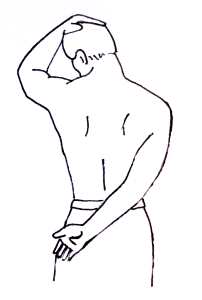
– Rotate your head to the right so that your chin is pointing in the direction of your right knee
– Drop your chin down toward the knee
– Apply a gentle pressure to the back of the head with the right hand
– You should feel a gentle tension on the side of the back of your neck
Increase the stretch by placing your left arm behind your back and toward your right hip.
Lateral Neck Flexion Stretch
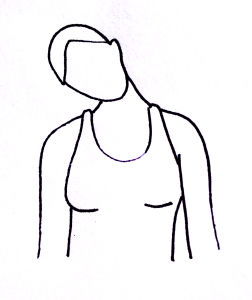
– Sit or stand with your head in a neutral position. Keep your chin elevated and drop your shoulders
– Slowly drop the right ear towards the right shoulder, being careful not to lift the left shoulder
– You should feel a gentle tension on the side of your neck
To increase the stretch, bring your right arm up and over your head. Grasp the left side of your head and gently pull it toward your right shoulder.
Head Swings
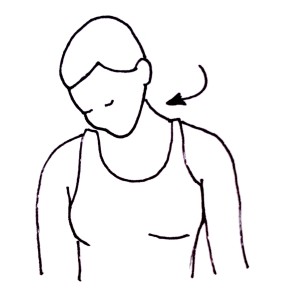
– Sit or stand with your head in a neutral position. Keep your chin elevated and drop your shoulders
– Slowly drop head toward chest, and then gently roll the right ear to the right shoulder
– Bring the head back to neutral, and repeat on the other side
Strengthening Exercises for the Levator Scapulae
Cat Back Stretch (Cervical Spine Extention)
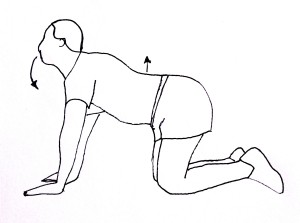

– Kneel on hands and knees in a relaxed position
– Arch your back, relax the muscles in your neck and gently let your head drop
– Reverse the pose, flatten your back and raise your head to look up at the ceiling
– Hold for a few seconds and repeat
The strengthening occurs during extension, when the head is elevated.
Increase the stretch by pulling your shoulder blades together when looking up.
Shrugs (Scapular Elevation)
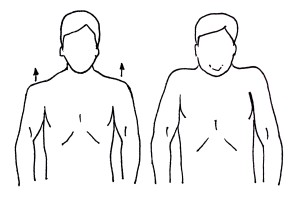
– Sit or stand with your head in a neutral position. Keep your chin elevated and drop your shoulders
– Shrug or raise shoulders up towards your ears, ensuring that you do not roll your shoulders forward (pull your shoulder blades towards each other at the back)
– Hold for a few seconds, then drop the shoulders to starting position. Repeat.
The strengthening occurs during elevation, when the shoulders are shrugged.
Increase the exercise by adding a weight for increased traction.
Head Rolls (Cervical Spine Rotation)
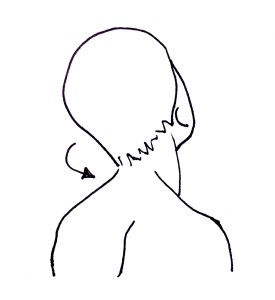
– Sit or stand with your head in a neutral position. Keep your chin elevated and drop your shoulders
– Slowly and gently roll head in a clockwise circle three times.
– Repeat in the opposite direction
The strengthening occurs during rotation, when the head rolls from front to back.
References
- http://warrenkingmd.com/body/hand_outs/HO-Levator%20Scapulae.pdf
- http://www.exrx.net/Muscles/LevatorScapulae.html
- http://www.kybbmassage.com/blog/stiff-neck-blame-levator-scapula
- http://www.medic8.com/healthguide/sports-medicine/levator-scapulae-syndrome.html
This article/video is for educational purposes only; do not attempt without your physician’s clearance. If you are in pain or injured, see your physician.
Copyright © Vidal Sports LLC 2018




